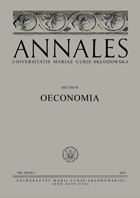Costs of IPO in Poland
Costs of IPO in Poland
Author(s): Dorota Podedworna-TarnowskaSubject(s): Economy, Financial Markets
Published by: Wydawnictwo Naukowe Uniwersytetu Marii Curie-Sklodowskiej
Keywords: direct costs; indirect costs; IPO; underpricing
Summary/Abstract: Theoretical background: Entering the stock market is an important moment in the development of a company. However, whether the timing of the decision is determined by capital needs or driven by attractive market conditions is debated in literature studies. On the other hand, neither in financial theory nor in practice there is a single universal formula, the use of which would enable the determination of the most favourable capital structure for a given company, reconciling both the optimum profitability of its own capitals and a reasonable scale of risk. The decisions regarding the selection of sources of financing depend on several factors. There is no question the cost of capital is an important criterion used by companies when deciding on a financing decision. In the case of initial public offers (IPO), the total costs consist of directand indirect costs. This study fills a specific gap in the literature due to the lack of such analyses based on data coming from the Polish market especially in the context of the type of IPO and market conditions.Purpose of the article: The purpose of this article is to present the results of a study on the costs of IPO conducted on the Warsaw Stock Exchange (WSE) between 2005 and 2020.Research methods: The hypotheses were verified using the statistical analysis and an econometric linear regression. Analysis covers 249 companies debuting on the WSE between 2005 and 2020. Information on the costs of the analysed offers was obtained from the companies’ current reports published after the completion of the share subscription.Main findings: The analysis confirmed that indirect cost of the offer are higher than direct costs. Although the average total costs of the offer are highest in the case of the issuance of new shares but they are not statistically significant. Furthermore, the higher the value of the offer, the lower its total cost. The interest rates affect the total cost of IPO but the total offer costs may not be directly explained by the activity on the IPOs market. The results of the analysis indicate that the explainability of the estimated model is the biggest for the direct costs. There is also a significant difference between the years with the highest and the lowest total costs of the offer.
Journal: Annales Universitatis Mariae Curie-Skłodowska, Sectio H Oeconomia
- Issue Year: LVI/2022
- Issue No: 4
- Page Range: 135-160
- Page Count: 26
- Language: English

